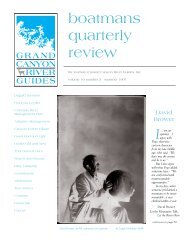Tamarisk Leaf Beetle Update:Stepping Up Monitoring EffortsSatellites circling the earth have captured imagesof ribbons of green along the Colorado <strong>River</strong>corridor in <strong>Grand</strong> <strong>Canyon</strong>, with over 900 acresof that green dominated by invasive, exotic tamarisktrees (Tamarix spp.). Most of you have seen thesetrees up close and know them intimately. In the pasttwo years, you may have noticed that they are losingtheir foliage earlier than usual. This is a direct resultTamarisk leaf beetle. Photo courtesy NPS.what we have done in the past and taking it to the nextlevel—that of the watershed!In an effort to get accurate information to thepublic and answer questions from the field in a timelyfashion, we will provide bi-annual updates on beetlemovement and response planning in the bqr. Look fora map of the beetle’s current distribution and a summaryof the 20<strong>11</strong> movement in the next issue!For now, here is the quick update:• The first beetle larvae were detected in the park in2009, but their manner of arrival is uncertain.• In 2010, beetles were found at stock tanks nearTuweep, up major drainages (e.g. Stone and KanabCreeks), and non-continuously from Glen <strong>Canyon</strong>Dam to Pearce Ferry. Tamarisk defoliation was visibleby late August.• In 20<strong>11</strong>, beetle sampling was implemented on everypossible science work trip; to date we have sampledbeetles on five river trips; seven trips total by thetime you read this article.• The gaps in distribution from the 2010 map arestarting to fill in this year, with beetles spreading toat least <strong>River</strong> Mile 208.of tamarisk leaf beetles’ arrival in the park. Whilepurposefully imported into the u.s. to manage tamarisk,National Park Service managers did not activelyrelease them in <strong>Grand</strong> <strong>Canyon</strong>. However, we now havethe opportunity to proactively, comprehensively, andthoughtfully prepare for the future.This watershed-scale change brings with it amazingopportunities for multiple stakeholders to be involvedin how we respond to this change, to have input intovarious management actions, and also for people fromvaried backgrounds to work in the field together. Asthis will definitely require a team effort, nps staff wantsto express our gratitude for the early offer of help andsupport that gcrg leaders have expressed. We have agreat relationship to build on. Many gcrg members,commercial companies, private boaters, affiliatedtribes, and individuals have worked alongside nps staffto restore native vegetation at campsites, excavatearcheological sites, remove invasive plants from thecorridor and side canyons, monitor wildlife, delineatetrails, and implement recovery actions for endangeredfish. This could indeed be one of our capstone, multistakeholder,large-scale efforts, truly expanding onTamarisk leaf beetle copulation. Photo courtesy NPS.• No adult beetles or larvae have been detectedbetween Diamond Creek and the park’s boundarywith Lake Mead, but they are very abundantupriver from Lees Ferry in Glen <strong>Canyon</strong> NationalRecreation Area.• In theory, it should take three to five years fortamarisk mortality, so expect to see defoliatedpage 10grand canyon river guides
stands greening up again in the spring with mortalityunderway in the next few years.• Tamarisk beetles are not known to eat or damagenative vegetation, although they cluster and spendtime on natives. There are other beetles that lookvery similar to tamarisk leaf beetles—in particular,one that was found in abundance on spiny asterplants in 20<strong>11</strong>. If you see beetles on native vegetation,please take photos and get them to Lori Makarickvia mail or email.So, from here, what is the plan? The park’s new WatershedStewardship Program, lead by park ecologistDr. Todd Chaudhry, is taking a leadership role withlarge-scale restoration planning and implementation.Dr. Chaudhry (see companion article on page 12) hasa strong and passionate nps team working alongsidehim, providing technical expertise and moral supportto the program, and some solid baseline informationfrom the river corridor. We have southwestern willowflycatcher and avian surveys results, and we have mapsof overall vegetative community distribution thanksto the gcmrc mapping efforts. We also know whichareas had good riparian habitat and high biologicaldiversity in the past, so we will incorporate those datainto the planning. We have started growing riparianplants at the park’s nursery, and staff and volunteerswill continue to collect seed and cuttings next year. Weare looking for funds to expand our nursery to meetthe needs of large-scale restoration and also to supportvolunteerism in the field. Todd will be coordinatingworkshops in the future, and he will definitely contactgcrg for participation.In order to move forward progressively, the nextstep is truly to have a pilot project. Here is one bit ofgreat news on that front:On July 13, 20<strong>11</strong>, the <strong>Grand</strong> <strong>Canyon</strong> Association,in partnership with the National Park Service, wasawarded a grant from the Nina Mason Pulliam CharitableTrust for $104,500 to support a two-year pilotproject aimed at testing ecosystem restoration methodsand mitigating impacts to cultural resources at GraniteCamp and Monument Creek in <strong>Grand</strong> <strong>Canyon</strong> NationalPark. These sites are very popular with backpackersand river runners; however, like many sites withinthe Colorado <strong>River</strong> corridor, they have been adverselyimpacted by the operation of Glen <strong>Canyon</strong> Dam, highrecreational use, and the introduction of non-nativespecies, particularly tamarisk. Project goals includedeveloping methods to restore native riparian plantcommunities and wildlife habitat, recovering data andstabilizing a threatened prehistoric archeological site,and enriching our visitor experience. In light of theMile 6 tamarisk defoliation. Photo courtesy NPS.likely impacts that the introduced tamarisk leaf beetle(Diorhabda spp.) will have on tamarisk-dominated riparianecosystems, the proposed work at Granite Campwill be of particular value in assessing the feasibilityof proactively replacing tamarisk with native riparianshade trees along the mainstem. An interdisciplinaryteam of park staff will conduct assessments of both sitesthis September to identify specific restoration potentialand begin to develop strategies.This site was chosen because we can access the siteon foot (versus river), making volunteer participationeasier both logistically and financially. The park is alsointerested in working in portions of the watershed thatare valued by multiple recreational users. This winter,staff will focus on nepa compliance and preparing animplementation plan. We will build upon the lessonslearned from the Lees Ferry restoration project, thework at Soap Creek and Owl Eyes, and other projectsin similar environments. There will be lots of waysindividuals and groups can help—with the planting,watering, collecting plant material, transporting supplies,coming up with creative solutions to complexlogistical challenges, and giving input and suggestionsalong the way. Stay tuned for more news from ourWatershed Stewardship Program!For more background information on the tamariskleaf beetle, please refer to “<strong>Grand</strong> <strong>Canyon</strong> Assault” inthe Winter 2009–2010 issue of the Boatman’s QuarterlyReview and “The Tamarisk Leaf Beetle—What itMeans to You, the Colorado Plateau & <strong>Grand</strong> <strong>Canyon</strong>”presentation from the 20<strong>11</strong> <strong>Guides</strong> Training Seminaravailable under Guide Resources / gts Library from thewww.gcrg.org website.Lori Makarickvegetation Program Manager gcnplori_Makarick@nps.govboatman’s quarterly review page <strong>11</strong>
















